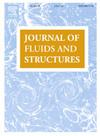具有规定动态振荡上游气缸的柔性安装串联气缸系统尾迹振动响应实验研究
IF 3.4
2区 工程技术
Q1 ENGINEERING, MECHANICAL
引用次数: 0
摘要
通过实验分析,研究了与上游圆柱串联的柔性安装圆柱的尾迹诱发振动。上游圆柱体承受强迫振荡,峰值振幅为圆柱体直径(D)的0.5倍,频率为下游圆柱体固有频率的0.5至2倍。通过在上游气缸上施加规定的运动,本研究与传统的串联气缸布置的WIV研究不同。在我们的方法中,下游圆柱体对尾迹做出响应,尾迹具有独立控制的动力学特征,例如尾迹宽度和脱落频率,与源圆柱体的几何形状和固有特性不同。在S/D = 4,6,8的不同中心间距上,研究了U * = 2.9 - 18.0的减速速度范围内的振荡幅度、频率和流动力,对应于650至3500的雷诺数。分别使用氢泡成像和体积粒子跟踪测速(PTV)技术进行定性和定量流场评估。动态响应表明,在不同的频率比下,下游汽缸均经历了WIV。由于在每种情况下产生不同的尾迹动力学,下游圆柱体经历连续的大幅度振荡,持续到在频率比为1时测试的最高减速速度。在频率比为2时,振荡的开始延迟到更高的降速。观测到的振荡频率内容与规定的上游运动直接对应,表明检测到来流尾迹。下游发展的尾迹结构对上游气缸的动力特性有很强的依赖性。q -准则分析揭示了串联对下游的主导结构及其三维性质。此外,利用适当的正交分解技术进行时空模式分析,阐明了在每个上游条件下观察到的各种下游圆柱体响应的相干涡结构。本文章由计算机程序翻译,如有差异,请以英文原文为准。
Experimental study of wake-induced vibration response in a flexibly mounted tandem cylinder system with a prescribed dynamically oscillating upstream cylinder
The wake-induced vibration (WIV) of a flexibly mounted circular cylinder, positioned in tandem with an upstream circular cylinder, is investigated through experimental analysis. The upstream cylinder undergoes forced oscillations with a peak-to-peak amplitude of 0.5 times the cylinder’s diameter () and frequencies ranging from 0.5 to 2 times the natural frequency of the downstream cylinder. By imposing a prescribed motion on the upstream cylinder, this study diverges from conventional investigations of WIV in tandem cylinder arrangements. In our approach, the downstream cylinder responds to a wake characterized by independently controlled dynamics – such as wake width and shedding frequency – distinct from the geometry and inherent characteristics of the source cylinder. This study examines oscillation amplitudes, frequencies, and flow forces in a reduced velocity range of = 2.9 – 18.0, corresponding to Reynolds numbers of 650 to 3500, across various center-to-center spacings of = 4, 6, 8. Qualitative and quantitative flow field assessments are conducted using hydrogen bubble imaging and a volumetric Particle Tracking Velocimetry (PTV) technique, respectively.
The dynamic response shows that the downstream cylinder experiences WIV for each forcing frequency ratio. Due to the distinct wake dynamics created in each case, the downstream cylinder experiences continuous large-amplitude oscillations persisting to the highest reduced velocity tested at a frequency ratio of 1. At a frequency ratio of 2, the onset of oscillations is delayed to higher reduced velocities. The frequency contents of the observed oscillations directly correspond to the prescribed upstream motion, indicating the detection of the incoming wake. The wake structure developed downstream shows a strong dependence on the dynamic characteristics of the upstream cylinder. A Q-criterion analysis reveals the dominant structures prevailing downstream of the tandem pair and their three-dimensional nature. Additionally, a spatiotemporal mode analysis using the proper orthogonal decomposition technique elucidates the coherent vortical structures responsible for the various downstream cylinder responses observed in each upstream condition.
求助全文
通过发布文献求助,成功后即可免费获取论文全文。
去求助
来源期刊

Journal of Fluids and Structures
工程技术-工程:机械
CiteScore
6.90
自引率
8.30%
发文量
173
审稿时长
65 days
期刊介绍:
The Journal of Fluids and Structures serves as a focal point and a forum for the exchange of ideas, for the many kinds of specialists and practitioners concerned with fluid–structure interactions and the dynamics of systems related thereto, in any field. One of its aims is to foster the cross–fertilization of ideas, methods and techniques in the various disciplines involved.
The journal publishes papers that present original and significant contributions on all aspects of the mechanical interactions between fluids and solids, regardless of scale.
 求助内容:
求助内容: 应助结果提醒方式:
应助结果提醒方式:


